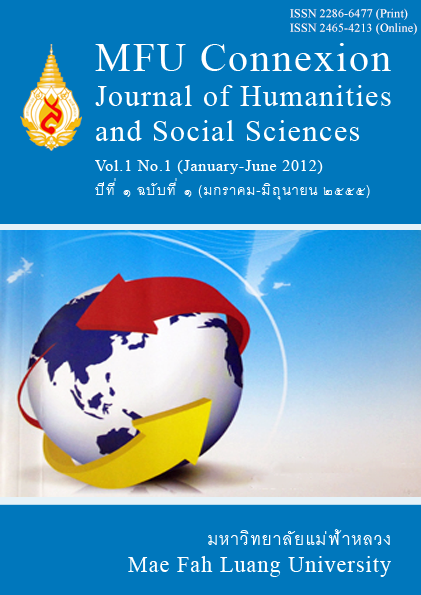?araj jàaŋ níi (อะไรอย่างนี้): The grammatical functions and social categories as a new final particle in Thai language
Main Article Content
Abstract
This paper aims to study and to make a contribution to the description of ? araj jàaŋ níi as final particle in Thai by looking at its grammatical functions as well as its social categories. The data are collected by recordings and conversations of 80 Bangkok Thai speakers aged 6-80. These data are analyzed by using the syntactic notion of dependency and co-occurrence in sentence. This paper challenges the current analysis of final particle as the small words or phrases which do not have any syntactic relationship to the sentence or utterance and are usually added to the end of colloquial speeches. This paper argues that ?araj jàaŋ níi is being grammaticalized and lexicalized from noun phrase to word as final particle. There are many its variable forms, such as ?a raj jàaŋ ŋíi, ?a raj jàaŋ ŋía, ?a raj ŋía, raj ŋía and so on.
The account of ?araj jàaŋ níi as social categories is based on Bakhtin’s notion of Heteroglossia as it is integrated within the systems of modality and evidentiality. Thai speakers use final particle ?araj jàaŋ níi as a discourse connective and interpersonal marker. A comparison of speakers divided into eight generational groups. The quantitative analysis found that ?araj jàaŋ níi is highly used in the ages of 21-30, 11-20, 31-40 and 41-50 in order of frequency. Meanwhile, it is not found in speakers of 71-80 years old, nor in speakers of 6-7 years olds. These different uses can be discussed from the heteroglossia function. Young Thai people interpret ?araj jàaŋ níi in an adult-like fashion to become more adult on the one hand, Thai adults fashionably use ?araj jàaŋ níi to perform their modern style and express the youthfulness in the other.
This paper also argues that Thai particles not only associate to pragmatic use of expressing speakers’ attitudes, but also relate to discourse context of speakers to identify their situated identity by using and designing the different form of particles.
Article Details
Copyright
Connexion: Journal of Humanities and Social Sciences has an exclusive right to publish the accepted articles in any form. However, the author retains the following rights:
1. The right to the ownership of the article;
2. The right to use all or part of the article in his/her other works;
3. The right to re-produce the article for personal use or for use in the author’s organisation, in which case the author must obtain permission from Connexion: Journal of Humanities and Social Sciences;
4. The right to make copies of all or part of the work for educational use or for the author’s use in classroom teaching; and
5. The right to include the work (both the preprinted and printed versions) in an institutional repository.
References
Angkapanichkit, J. (2009) ‘The variation of Thai final particles: Language and age’, in Prasithiratasint, A. and Sankaburaraksa, S. (eds.) The language variation in Thai society, Bangkok: Chulalongkorn University Printing House.
Bandhumedha, N. (2006) Thai grammar, Bangkok: Faculty of Arts, Chulalongkorn University.
Benjatanasompatti, P. (2003) The Study of the sentence usage of kindergarten children at age 5-6 in Bangkok, Master’s Thesis, Chulalongkorn University, Bangkok.
Bhamoraput, A. (1972) Final particles in Thai, Master’s Thesis. Brown University, Rhode Island.
Cooke, J. R. (1989) Thai sentence particles and other topics, Pacific Linguistic, Series A-80: Papers in South-East Asian Linguistics No.12, Canberra : The Australian National University.
Cooke, J. R. (1992) Thai sentence particles: Putting the puzzle together, SIL Paper, Nakornpathom: The Research Institute of Language and Culture for Asian Development.
Labov, W. (1972) Language in the inner city, Philadelphia: University of Pennsylvania.
Peyasantiwong, P. (1981) A study of final particles in conversational Thai, Doctor’s Dissertation. University of Michigan.
Prasithiratasint, A. (2009) ‘Parts of speech in Thai language’, in Prasithiratasint, A. and Sankaburaraksa, S. (eds.) The language variation in Thai society, Chiang Rai: Chorp Karnpim.
Starosta, S. (1988) The case of lexicase: An outline of lexicase grammatical theory, London: Pinter.
Thikashunhatian, R. (1984) Final particle in Thai northeastern dialect, Khonkaen: Khonkaen University.
Uppakitsilapasarn. (1990) Thai reference grammar, Bangkok: Thai Wattanapanich.


